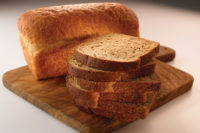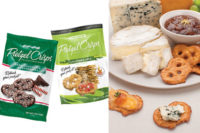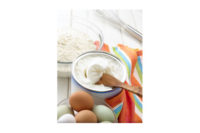Exotic superfruits aren’t the only fruits in town loaded with health benefits, consumers are discovering. Many perennial favorites like cherries, blueberries and raspberries are packed with vitamins, antioxidants and other nutrients. And because these fruits are typically available year-round in a variety of easy-to-use, affordable forms, bakers and snack producers appreciate them.
The U.S. Department of Agriculture’s newest nutrition guide, MyPlate, encourages consumers to fill half of their plates at mealtimes with fruits (20%) and vegetables (30%). Given all of the publicity on fruit and superfruits’ healthful and nutritional benefits, and people’s positive perception of fruit in general, most consumers probably don’t have any difficulty fulfilling the first part of this dietary goal. After all, who can resist a bowl of juicy berries or melon balls that just also happen to be loaded with antioxidants and vitamins?
But MyPlate’s Food Group comprises more than fresh fruit. It also includes 100% fruit juice and canned, frozen, dried and pureed fruit. As bakers and snack manufacturers know, the latter forms and others are suitable for creating better-for-you, fruit-filled baked goods and snacks for today’s health-conscious consumers. Another plus for bakers and snack producers: Numerous fruits and superfruits are available in these versatile forms.
Dried and true
“The great thing about prunes is that they’re available in so many different forms, which allows for creative innovation in bakeries around the world,” says Tom Leahy, a spokesperson for Sunsweet Growers Inc., Yuba City, Calif. “This past year, we have seen strong growth in demand for diced pieces, puree and powder.”
(Will there be an adequate supply of prunes and other fruits to meet bakers’ and snack producers’ needs this year? Read “2014 fruit forecast,” on www.snackandbakery.com this month to find out.) Prunes, which are high in soluble fiber and potassium, can be easily incorporated into a variety of bakery applications, including breads, sweet goods, cereals, cereal bars, confections and snacks. “Bakeries use prune dices instead of raisins or cranberries,” Leahy says. “Additionally, prune puree is being used as a replacement for sugar and fat. And an important emerging trend is the use of prunes in gluten-free bakery applications for moisture retention.”
Donn Zea, executive director, California Dried Plum Board, Sacramento, cites puree, paste and diced pieces as the most common dried plum form requested by bakers and snack manufacturers. “Dried plums also offer bakers a nutrient-rich opportunity to develop rich and moist bakery products with a significant reduction in fat and calories,” he says, adding that some dried plum brands are offering puree as a low-fat nutritious substitute for butter in baked goods.
Other dried plum products available domestically and in international markets are individually wrapped prunes, flavored prunes, diced prunes and coated prune pieces. “The popular California Bakery in Milan, Italy, is now partnering with the California Dried Plum Board, featuring main dishes, bakery items and desserts made with California prunes,” he adds.
A ubiquitous dried fruit that continues to be popular among food processors as they develop new and reformulate existing products is the raisin. “As bakers are constantly seeking to simplify their labels and achieve more natural finished products, raisin paste and raisin juice concentrate are seeing a surge in sales,” says Larry Blagg, senior vice president of marketing for the California Raisin Marketing Board, Fresno. “Raisin paste is used as a sugar substitute in muffins and artisan breads, and can be mixed with more expensive exotic fruits to help keep costs in line. Raisin juice concentrate is also used as a natural coloring agent in some breads and to provide a rich, dark, caramelized flavor to a wide variety of plated desserts.”
Whole raisins, meanwhile, are turning up in more health and granola bars. “They provide natural sweetness and nutrients, such as fiber and potassium,” Blagg says, adding that U.S. Department of Agriculture (USDA) Economic Information Bulletin No. 71 also ranks raisins as the “most economical dried fruit.”
Cherries and berries
As with prunes, bakers are requesting more chopped and diced, dried cherries, as well as small, whole dried cherries. “Baking and snack trade R&D chefs are developing new products with ‘fruit piece’ identity,” explains Steve Kollas, vice president of technical services, Oregon Cherry Growers, Salem, Ore., a grower-owned cooperative of family farms that packs and processes an average of 25,000 to 30,000 tons of cherries annually. “The consumer trend reflects a 90% interest in cherries as a key ingredient compared to other fruits at 74%.”
Kollas says that there is also “considerable demand” for frozen or infused frozen cherries for bakery filling applications. Other common cherry forms are semi-dried, pureed, infused, stabilized and juiced; sizes include whole, half, quartered, sliced, diced and granules. “All these forms offer the R&D chef versatility and solutions to their unique creations,” he says.
And those creations may eventually be joining a host of other cherry-containing products already on the market. “We’re seeing dried cherries featured as a key ingredient in cereals, trail mixes, cookies, energy bars, breakfast and snack bars and smoothies,” Kollas says. “Consumers are eating their fruit in baked items 59% of the time, and we are seeing cherries in more cakes, pastries and sweet goods.”
When it comes to raspberries and blackberries, individually quick frozen (IQF), dried and freeze-dried products are in “large demand” by bakers and snack producers, says Cat McKenzie, marketing director of the Oregon Raspberry & Blackberry Commission, Blodgett, which represents more than 200 growers and 12 packers of raspberries and blackberries in the state. “Black raspberries are being sought out in particular for freeze-dried products used by the health and wellness industry [due to] their exceptional polyphenolic profile.”
High on the list of new products made with Oregon blackberries and raspberries are snack bars, says McKenzie. Bakery fillings and toppings, meanwhile, continue to be popular as well.
Blueberries—referred to as nature’s “little blue dynamos” by the U.S. Highbush Blueberry Council (USHBC), Folsom, Calif.—are available year-round in a wide range of formats, including frozen, IQF, dried, liquid (puree, juice and concentrate), canned, osmotically preserved, freeze-dried and dehydrated powder. Most bakers and snack manufacturers are well aware of their versatility and nutritional benefits and thus include them in baked goods; snack, energy and meal-replacement bars; granola and trail mixes; mixes; fillings; cereals; beverages; and more. And given that more than 1,300 new blueberry products were introduced last year, according to the USHBC, more new creations are sure to appear on store shelves soon.
The real superfruits
Cherries, blueberries, raspberries, blackberries, raisins, prunes and other commonly available fruits have been used in baked goods and other foods for so long that some people don’t think of them as superfruits. To these consumers, exotic fruits such as acai berry, goji berry, dragon fruit, manogsteen, pomegranates and passion fruit, are superfruits loaded with vitamins, antioxidants and other beneficial nutrients.
But nutritional studies, educational programs, advertising campaigns and other efforts by various fruit industries and organizations are prompting consumers to take a closer look at the health and nutritional benefits associated with these enduring favorites. They’re discovering that their favorite fruits are superfruits, too.
“Dried plums have a strong position in the superfood/superfruit, snack and bakery categories for reasons related to their nutrient profile,” says Zea. “They are nutritious, providing two nutrients of concern identified by the [USDA’s] Dietary Guidelines. Dried plums have potassium and are a good source of fiber (3 g. per 40-g. serving).”
Another study suggests that dried plums may have a prebiotic benefit to maintaining overall gut health, he notes. In addition, a clinical trial published in the British Journal of Nutrition, developing research and numerous animal studies conclude that dried plums may reverse bone loss and preserve bone structure, reducing the risk of osteoporotic fracture in post-menopausal women.
“The naturally occurring sugars [in dried plums] include fructose and glucose and almost no sucrose–the fermentable carbohydrate associated with dental caries,” Zea continues. “They contain the sugar alcohol sorbitol, which is noncariogenic. Dried plums satisfy and curb appetite more than a similarly sweet, low-fat cookie, perhaps by lowering glucose or appetite-regulating hormones. Sorbitol is slowly metabolized by the body and along with dietary fiber may contribute to dried plums’ low glycemic index.”
Cherries, meanwhile, are nutrient-dense and an excellent source of antioxidants, with substantial amounts of vitamin C, fiber and minerals, such as potassium, magnesium and iron, says Kollas. Research also reveals that the red orbs can be a sleep aid and help reduce joint pain and stiffness. And consumers are taking note. “In a recent survey, we’ve learned that consumers associate cherries as having health benefits, more so than superfruits like pomegranates and acai,” he adds.
Similarly, blackberries and raspberries are both “nutritionally exceptional antioxidant fruits,” says McKenzie. “The polyphenol profile of these berries provides anthocyanins unavailable in other fruits. Research into the polyphenolic properties of raspberries, including black raspberries and blackberries, are ongoing in areas such as cancer, brain aging, diabetes, heart disease and metabolism. The high fiber content of both blackberries and raspberries contribute to their high health benefits in comparison to other fruits and even vegetables.”
According to the USHBC, high amounts of flavonoids, such as anthocyanins, give blueberries their deep color. The blue orbs also contain many naturally occurring antioxidants, such as vitamins C and E, which are thought to help protect the body against the damaging effects of free radicals and chronic diseases associated with aging. In addition, blueberries are virtually fat-free; low in calories, sodium, carbohydrates and cholesterol; and a good source of fiber and manganese.
As with cherries, more people are aware of blueberries’ benefits. USHBC consumer research in four regions of the U.S. shows that consumers are identifying blueberries with antioxidants and believe blueberries are a healthy food.
So while exotic superfruits like manogsteen, dragon fruit and passion fruit are in the spotlight for their nutritional content (and often their unusual names and appearance), longtime favorites like cherries, blueberries, raspberries, blackberries and others are being rediscovered by many consumers for their potential health benefits. And they can find these fruits in a host of baked goods and snack products, thanks to their many available forms and uses.
SIDEBAR
Fruit stand-ins
Bakers and snack manufacturers use fruit inclusions in recipes for a variety of reasons, including consistent performance, year-round availability, cost savings and longer end product shelf life. Inclusions also enable food processors create products with trending or customized flavors, including fruit, and added nutritional benefits.
Denise Radke, marketing manager for QualiTech Inc. says the Chaska, Minn.-based company frequently receives requests for fruit and superfruit inclusions containing one or more of the following: acai; blackberry; blueberry; tart cherry; clementine; cranberry; guava; key lime; mango; and pomegranate. “A great taste profile and their higher antioxidant content are key attributes behind their popularity,” she explains. “Delivering fruit content—not merely flavor—is a common requirement. Powdered fruit forms are often used, as they provide more flexibility in creating customized inclusions.”
QualiTech’s inclusions are typically used in baked goods (breads, cookies, bagels, cakes, muffins, dry mixes and more), snacks (chips, tortilla chips, pretzels, popcorn, cold-pressed or baked snack or nutrition bars, and more) and breakfast foods (cereals, pancakes, waffles, muffins, coffee cakes and so on). Radke says the company is receiving requests for combinations or pairings of fruits, such as blueberry/pomegranate or acai/blueberry, for some of these items.
In addition to enabling customers to give a baked good or snack a specific taste, inclusions be used to add value to products by adding fiber, protein or fruit content; reducing sugar or fat; or improving color or texture. They may also enable manufacturers to make claims that a product has no genetically modified organisms or is organic, all-natural, trans-fat-free, gluten-free or whole-grain. “QualiTech’s inclusions can be designed to nutritional contents equal to real superfruits or fruits, or even to deliver desired nutrients in more concentrated form than their whole fruit counterparts,” says Radke.
Mayer Brothers, West Seneca, N.Y. has seen a “high increase in requests for various Fruit Fibers including, but not limited to apple, organic apple, blueberry, cherry and cranberry,” says Russell Carlson of S.A. Carlson Inc., the exclusive sales and marketing organization in Yakima, Wash., that handles sales for all Mayer fibers. “These are typically requested in 40 mesh powders, but sometimes will be requested in 16 and 50 mesh as well.” S.A. Carlson also offers dehydrated fruit, individually quick frozen (IQF) and block-frozen fruit and vegetables, fruit and vegetable purees, juice concentrates, extracts, flavorings and more.
“The Fruit Fibers carry natural benefits from high fiber to antioxidants—depending on the fruit used—to necessary, basic vitamins,” says Carlson. For instance, besides dietary fiber, the Apple Fiber contains vitamins C and A, calcium, iron and niacin. Blueberry, Cherry and Cranberry Fibers, meanwhile, have natural vitamins and antioxidants.
“Because of this, we see the fibers being used as a low-cost, natural extender to replace various ingredients in formulations,” Carlson says. Products that use these fibers include breakfast and snack bars, cereals, breads, pastry, pie and cookie fillings, dry mixes (cakes, muffins, donuts and more) and toaster pastry fillings.













